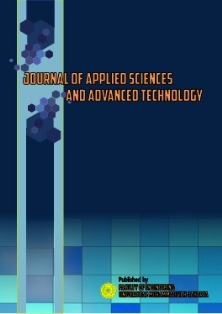Identification of Palm Oil Mill Throughput Capacity of 60 tons/hour (Case Study at XYZ Palm Oil Mill)
DOI:
https://doi.org/10.24853/jasat.2.3.83-86Keywords:
ability, factory capacity, material balance, palm oilAbstract
Throughput is the ability of a company's production unit to process raw materials into final products that have value, in accordance with established standards. Palm Oil Mill (PKS) is a processing company for raw materials in the harvest of palm oil in the form of Fresh Fruit Bunches processed into Crude Palm Oil (CPO) and Palm Kernel Oil (PKO) products and their by-products in the form of solid waste (empty bunches, fiber, shells) and liquid. PKS production can be achieved throughput produced by looking at the production process that occurs in each work unit, namely: the value of the capacity of the stew is done, sequencing time, steam boiler requirements, Material Balance. The capacity owned by PKS XYZ is 60 tons/hour, does not meet the targeted throughput, where the sterilizer capacity is only able to reach 45 tons/hour, sequencing time is 45 minutes, the steam boiler produced is not sufficient to produce 60 tons of PKS/hour, and the existing Material Balance is not met, which are 38 tons/hour.Downloads
References
Departemen Perdagangan R.I. 1987. Badan Penelitian dan Pengembangan Departemen Perdagangan R.I. Jakarta.
A. Yustanigwarno, Fitriyono, 2012, Proses Pengolahan Dan Aplikasi Minyak Sawit Merah Pada Industri Pangan, VITASPHERE, Volume II, Agustus 2012, hal. 1-11 ISSN: 2085-7683.
Alatas, Andi, 2015, Trend Produksi dan Ekspor Minyak Sawit (CPO) Indonesia, Jurnal AGRARIS, Vol.1 No.2, Juli 2015, Hal. 114-124.
Anonim. 2003. Kernel Crushing Plant (KCP). PT. SMART tbk. Agribisnis Division. Medan.
Anonim. 2010. PT. Sawindo Kencana. Company Profile dan Laporan Produksi Harian Laboratorium. Bangka Barat.
Hidayat, Rakhmad, 2013, Analisis Komoditas Unggulan Sub Sektor Perkebunan Di Kabupaten Bengkayang Provinsi Kalimantan Barat, Jurnal Social Economic of Agriculture, Volume 2, Nomor 1, April 2013, hlm 54-66.
Kasir, ST. 2010. Teknik dan Produksi Pabrik Kelapa Sawit (Palm Oil Mill). http://teknikproduksipabrikkelapasawit.blogspot.comzx=1793b33ce87bd475.
Lubis. A.U. 1992. Pengolah Tandan Buah Segar (TBS) Kelapa Sawit. Pusat Penelitian Kelapa Sawit Marihat. Medan.
Lubis. A.U. 1994. Pengantar Manajemen Perkebunan Kelapa Sawit (Elaeis Guineensis Jacq.). Pusat Penelitian Kelapa Sawit. Medan.
Muhib, A.Z., S.T. 2006. Peralatan Pemindahan Bahan. ANDI Offcet. Yogyakarta.
Naibaho, P.M. 1998. Teknologi Pengolahan Kelapa Sawit. Pusat Penelitian Kelapa Sawit. Medan.
Pahan, Iyung. 2006. Panduan Lengkap Kelapa Sawit Manajemen Agribisnis dari Hulu hingga Hilir. Penebar Swadaya. Jakarta.
Pardamean, Maruli. 2008. Panduan Lengkap Pengelolaan Kebun dan Pabrik Kelapa Sawit. PT. Agro Media Pustaka. Jakarta.
Rantawi, Azhar Basyir, 2017, Pemanfaatan Basculator Dalam Operasional Decanter Untuk Menghitung Tonase Oil In Heavy Phase Di Pabrik Kelapa Sawit, Jurnal Citra Widya Edukasi Vol IX No. 2 Agustus 2017, Hal. 125-130.
Hendrawati, T. Y., Siswahyu, A., & Ramadhan, A. I. (2017). Pre-Feasibility Study of Bioavtur Production with HEFA Process In Indonesia. International Journal of Scientific & Technology Research, 6(04).
Rahardja, I. B., Sukarman, S., & Ramadhan, A. I. (2019). Analisis Kalori Biodiesel Crude Palm Oil (CPO) dengan Katalis Abu Tandan Kosong Kelapa Sawit (ATKKS). Prosiding Semnastek.
Satheesan, Menon. 2001. Boiler Operation, Fuel, and Steam Balance. Materi Training PT. SMART, Angkatan I. Medan.
Rahardja, I. B., Rikman, R., & Ramadhan, A. I. (2018). Analysis of Heat Transfer of Fiber Mesocarp of Palm Oil (Elaeis Guineensis Jacq) as Roof Building. Journal of Applied Sciences and Advanced Technology, 1(1), 1-8.
Rahardja, I. B., & Ambarita, S. R. (2017). Rencana Pengelolaan Limbah Cair Pabrik Kelapa Sawit (LCPKS) untuk Land Application. Jurnal Citra Widya Edukasi, 9(1), 9-16.
Rahardja, I. B., & Paryatmo, W. (2017). Analisa Dan Optimasi Sistem PLTGU Biomassa Gas Metan Dengan Daya 20 MW. Jurnal Teknologi, 9(2), 65-76.
Kamal, N. (2014). Karakterisasi dan Potensi Pemanfaatan Limbah Sawit. ITENAS, Bandung.
Downloads
Published
Issue
Section
License
COPYRIGHT POLICY
The author(s) of an article published in the Journal of Applied Sciences and Advanced Technology (JASAT) retains ownership of the intellectual property rights in work (s).
PUBLISHING RIGHTS
The author(s) of an article published in the Journal of Applied Sciences and Advanced Technology (JASAT) have unrestricted publication rights. The authors give the Journal of Applied Sciences and Advanced Technology (JASAT) the right to publish the article and designate the Faculty of Engineering Universitas Muhammadiyah Jakarta Publishing as the original publisher of the article.
LICENSING POLICY
JASAT is an open-access journal that follows the Creative Commons Non-Commercial 4.0 International License (CC BY-NC 4.0), which states that:

Under this license, the reusers must give appropriate credit, provide a link to the license, and indicate if changes were made. Users may do so in any reasonable manner, but not in any way that suggests the licensor endorses users or their use.
Please take the time to read the whole license agreement (https://creativecommons.org/licenses/by-nc/4.0/). As long as reusers follow the license conditions, the owner cannot withdraw these freedoms. The following components are included under this license:
 Attribution: Users must provide appropriate attribution, including a link to the license, and indicate whether or not they made any modifications. Users are free to do so reasonably, but not in a manner that indicates the licensee approves of their usage.
Attribution: Users must provide appropriate attribution, including a link to the license, and indicate whether or not they made any modifications. Users are free to do so reasonably, but not in a manner that indicates the licensee approves of their usage.
 NonCommercial: Users may not use the material for commercial purposes.
NonCommercial: Users may not use the material for commercial purposes.












_2.png)


1.png)

2.png)
